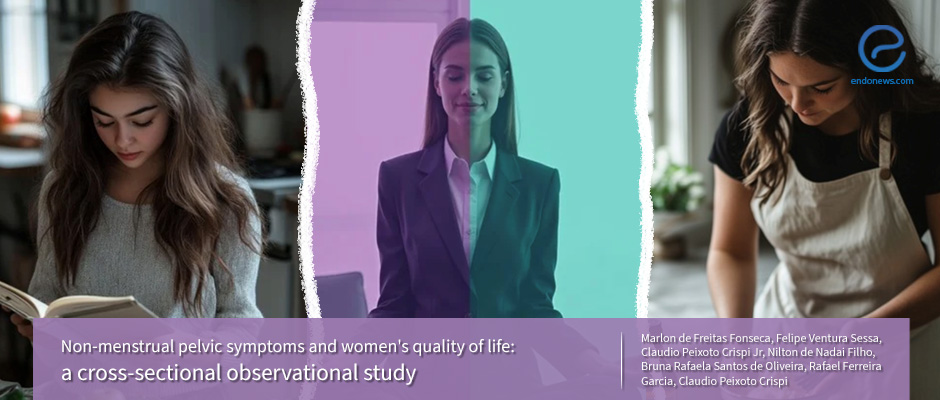Non-Menstrual Pelvic Symptoms in Endometriosis: Impact on Quality of Life
Jun 12, 2025
Non-Cyclic Pain and Dyschezia in Endometriosis Have Wide-Ranging Impact on Women's Well-Being
Key Points
Highlights:
- Non-menstrual pelvic pain and dyschezia significantly impair nearly all domains of health-related quality of life in women with endometriosis.
- Deep dyspareunia and dysuria have more limited or specific impacts, but still contribute to diminished well-being.
Importance:
- Pain outside menstruation is often overlooked in endometriosis care, yet it plays a major role in long-term health and psychosocial outcomes.
- Understanding the distinct effects of each symptom may help personalize treatment strategies.
What’s done here?
- A cross-sectional observational study assessed how four non-menstrual pelvic symptoms—deep dyspareunia, non-menstrual pelvic pain, dyschezia, and dysuria—affect health-related quality of life (HRQoL) in women with endometriosis.
- The study included 369 women undergoing minimally invasive surgery for deep endometriosis at a private center in Rio de Janeiro, Brazil.
- Symptom severity was rated using an 11-point numeric scale.
- HRQoL was evaluated with the Short Form 36 (SF-36) and the Endometriosis Health Profile-30 (EHP-30) questionnaires.
- Multiple linear regression models were used to assess associations between symptom severity and 19 HRQoL domains.
Key results:
- The most common symptoms were non-menstrual pelvic pain (58.5%) and deep dyspareunia (53.8%), followed by dyschezia (22.8%) and dysuria (8.4%).
- Nearly half of the women (45.9%) reported chronic pelvic pain lasting ≥6 months.
- Greater pain duration was positively correlated with higher symptom severity.
- Non-menstrual pelvic pain and dyschezia had the strongest negative impact on nearly all HRQoL domains.
- Deep dyspareunia significantly affected sexual functioning but had less impact on overall HRQoL.
- Dysuria had limited prevalence and weak associations, except for a coincidental link with self-image.
Strengths and Limitations:
- Large sample size and use of validated HRQoL tools (SF-36 and EHP-30); Data derived from a long-standing, clinically curated database are strengths of the study.
- Limitations are: Observational, uncontrolled study design, no adjustment for hormonal therapy or coexisting pain syndromes, lack of diversity in the sample (e.g., adolescents, postmenopausal, socioeconomically diverse, non-heterosexual women). and key psychosocial or clinical determinants of HRQoL were not assessed.
From the Editor-in-Chief – EndoNews
"This study is a compelling reminder that not all pain in endometriosis is menstrual—and not all suffering is visible on imaging or in operative reports. Fonseca et al. shift our attention to non-menstrual pelvic symptoms, especially pelvic pain and dyschezia, and their profound impact on quality of life. The finding that these symptoms affect nearly every domain of well-being underscores the need to listen more closely, ask better questions, and adopt a truly multidisciplinary approach to care. As we refine surgical and medical strategies, we must also prioritize how women live with endometriosis—not just how we treat it."
Lay Summary
Endometriosis is a chronic, inflammatory condition where endometrial-like tissue grows outside the uterus. It affects an estimated 6–10% of women of reproductive age and is known for causing painful symptoms such as dysmenorrhea (painful periods), dyspareunia (painful intercourse), chronic pelvic pain, and infertility.
A research team led by Fonseca et al. from Brazil recently published a study in PLOS One titled “Non-menstrual pelvic symptoms and women’s quality of life: a cross-sectional observational study.” The study evaluated how non-menstrual pelvic symptoms—especially pelvic pain and bowel-related discomfort—impact the health-related quality of life (HQoL) in women diagnosed with endometriosis.
Using two validated questionnaires (SF-36 and EHP-30), the researchers assessed 369 women and found that non-menstrual pelvic pain and dyschezia (pain during bowel movements) had the most widespread and negative effects across nearly all domains of HQoL. Deep dyspareunia also impacted quality of life, particularly in areas related to sexual function, though its overall burden was somewhat less.
Importantly, the study highlights that gastrointestinal symptoms associated with endometriosis may be under-recognized and under-treated. The authors emphasized the importance of a multidisciplinary approach in endometriosis management, acknowledging that many factors—beyond pelvic pain—contribute to patients' overall well-being.
“Further research in clinical settings may help identify which of these covariates may best contribute to improving the quality of life for women with deep endometriosis,” the authors concluded.
Research Source: https://pubmed.ncbi.nlm.nih.gov/40299924/
endometriosis pain non-menstrual pelvic pain non-menstrual dyschezia health-related quality of life (HQoLife) the Short Form 36 (SF36) the Endometriosis Health Profile 30 (EHP30)

